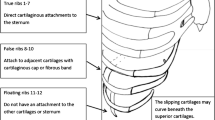Abstract
Objective
Management of cervicomedullary compression due to foramen magnum stenosis in achondroplasia remains controversial, especially for patients with no symptoms or mild symptoms. We examined the effectiveness of polysomnography (PSG) as an indicator for cervicomedullary decompression treatment.
Methods
We retrospectively reviewed nine achondroplasia cases (mean age 1 year and 9 months) treated from 2008 to 2015. All patients were examined by PSG, magnetic resonance imaging (MRI), and otolaryngeal fibroscopy. We analyzed demographic data, clinical presentation, degree and type of respiratory impairment, severity of foramen magnum stenosis and concomitant cervicomedullary compression, treatment (conservative or surgical), and clinical outcome.
Results
Eight of nine patients presented with no severe symptoms in the daytime. However, MRI revealed four severe, four moderate, and one mild case of cervicomedullary compression, and PSG demonstrated severe sleep apnea in four cases and moderate sleep apnea in five cases. All sleep apnea cases were obstructive or obstructive-dominant. Fibroscopy revealed no upper airway stenosis in six cases and mild stenosis in three cases. Four patients who had severe sleep-related respiratory disturbance on PSG and severe or moderate cervicomedullary compression were treated by cervicomedullary decompression. Three of these patients demonstrated improved sleep respiration soon after surgery, while one required temporary tracheostomy due to bilateral vocal cord paralysis caused by compression during intratracheal intubation.
Conclusion
Polysomnography can be a useful indicator for cervicomedullary decompression surgery, especially in cases of seemingly asymptomatic achondroplasia with severe foramen magnum stenosis.



Similar content being viewed by others
References
Afsharpaiman S, Sillence DO, Sheikhvatan M, Ault JE, Waters K (2011) Respiratory events and obstructive sleep apnea in children with achondroplasia: investigation and treatment outcomes. Sleep Breath 15:755–761
Bagley CA, Pindrik JA, Bookland MJ, Camara-Quintana JQ, Carson BS (2006) Cervicomedullary decompression for foramen magnum stenosis in achondroplasia. J Neurosurg 104(3 Suppl):166–172
Benglis DM, Sandberg DI (2007) Acute neurological deficit after minor trauma in an infant with achondroplasia and cervicomedullary compression. Case report and review of the literature. J Neurosurg 107(2 Suppl):152–155
Chaudhary B, Dasti S, Park Y, Brown T, Davis H, Akhtar B (1998) Hour-to-hour variability of oxygen saturation in sleep apnea. Chest 113:719–722
Colamaria V, Mazza C, Beltramello A, Polo A, Boner A, Antoniazzi F, Polo M, Luchini P, Sgrò V, Bernardina BD (1991) Irreversible respiratory failure in an achondroplastic child: the importance of an early cervicomedullary decompression, and a review of the literature. Brain and Development 13:270–279
Golpe R, Jimenez A, Carpizo R, Cifrian JM (1999) Utility of home oximetry as a screening test for patients with moderate to severe symptoms of obstructive sleep apnea. Sleep 22:932–937
Haga N (2004) Management of disabilities associated with achondroplasia. J Orthop Sci 9:103–107
Hecht JT, Francomano CA, Horton WA, Annegers JF (1987) Mortality in achondroplasia. Am J Hum Genet 41:454–464
Ho NC, Guarnieri M, Brant LJ, Park SS, Sun B, North M, Francomano CA, Carson BS (2004) Living with achondroplasia: quality of life evaluation following cervico-medullary decompression. Am J Med Genet A 131:163–167
Katz ES, Marcus CL (2005) Diagnosis of obstructive sleep apnea syndrome in infants and children. In: Sheldon SH, Ferber R, Kryger MH (eds) Principles and practice of pediatric sleep medicine. WB Saunders, Philadelphia, pp 197–210
Kushida CA, Littner MR, Morgenthaler T, Alessi CA, Bailey D, Coleman J Jr, Friedman L, Hirshkowitz M, Kapen S, Kramer M, Lee-Chiong T, Loube DL, Owens J, Pancer JP, Wise M (2005) Practice parameters for the indications for polysomnography and related procedures: an update for 2005. Sleep 28:499–521
Miyachi M, Uehara H, Hasegawa T, Yo R, Sakai T, Fujii N et al (2005) Severe respiratory failure and quadriplegia due to cervicomedullary–junction compression in an achondroplastic infant. J Jpn Pediatr Soc 109:523–527
Naski MC, Wang Q, Xu J, Ornitz DM (1996) Graded activation of fibroblast growth factor receptor 3 mutations causing achondroplasia and thanatophoric dysplasia. Nat Genet 13:233–237
Oishi M, Fukuda M, Yajima N, Yoshida K, Takahashi M, Hiraishi T, Takao T, Saito A, Fujii Y (2013) Interactive presurgical simulation applying advanced 3D imaging and modeling techniques for skull base and deep tumors. J Neurosurg 119:94–105
Pauli RM, Scott CI, Wassman ER Jr, Gilbert EF, Leavitt LA, Ver Hoeve J et al (1984) Apnea and sudden unexpected death in infants with achondroplasia. J Pediatr 104(3):342–348
Sisk EA, Heatley DG, Borowski BJ, Leverson GE, Pauli RM (1999) Obstructive sleep apnea in children with achondroplasia: surgical and anesthetic considerations. Otolaryngol Head Neck Surg 120:248–254
Tasker RC, Dundas I, Laverty A, Fletcher M, Lane R, Stocks J (1998) Distinct patterns of respiratory difficulty in young children with achondroplasia: a clinical, sleep, andlung function study. Arch Dis Child 79:99–108
Ueda M, Okutani R, Nakada K, Nakano T, Kinoshita A (2012) Anesthetic management during tracheotomy in a child with respiratory distress caused by severe intubation- induced glottic stenosis. J Anesth 26(3):449–452
White KK, Parnell SE, Kifle Y, Blackledge M, Bompadre V (2016) Is there a correlation between sleep disordered breathing and foramen magnum stenosis in children with achondroplasia? Am J Med Genet Part A 170A:32–41
Yamada Y, Ito H, Otsubo Y, Sekido K (1996) Surgical management of cervicomedullary compression in achondroplasia. Childs Nerv Syst 12:737–741
Zucconi M, Weber G, Castronovo V, Ferini-Strambi L, Russo F, Chiumello G, Smirne S (1996) Sleep and upper airway obstruction in children with achondroplasia. J Pediatr 129:743–749
Author information
Authors and Affiliations
Corresponding author
Ethics declarations
Conflict of interest
The authors declare that they have no conflict of interest.
Ethical approval
All procedures performed in studies involving human participants were in accordance with the ethical standards of the institutional and/or national research committee and with the 1964 Helsinki declaration and its later amendments or comparable ethical standards. For this type of study formal consent is not required.
Rights and permissions
About this article
Cite this article
Sano, M., Takahashi, N., Nagasaki, K. et al. Polysomnography as an indicator for cervicomedullary decompression to treat foramen magnum stenosis in achondroplasia. Childs Nerv Syst 34, 2275–2281 (2018). https://doi.org/10.1007/s00381-018-3880-0
Received:
Accepted:
Published:
Issue Date:
DOI: https://doi.org/10.1007/s00381-018-3880-0




